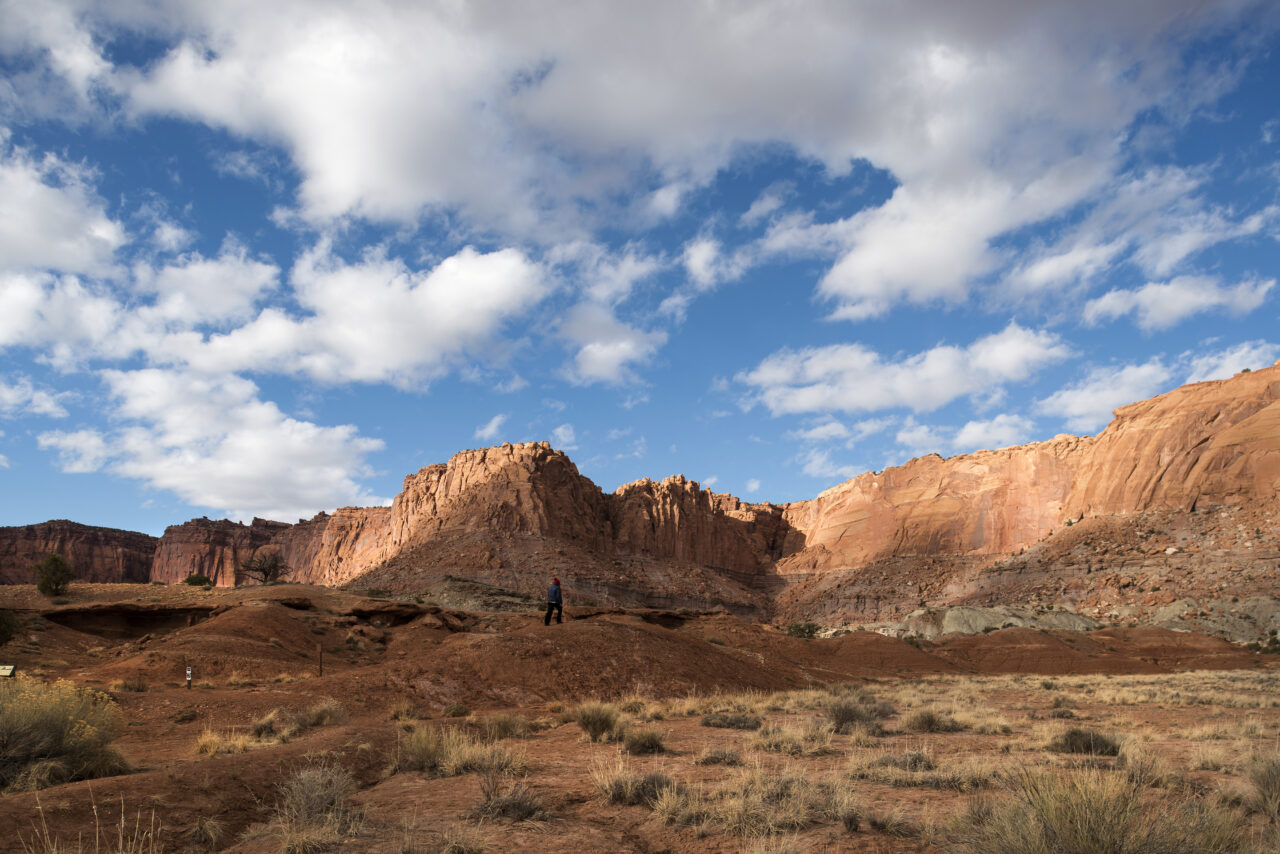Get more Southwest News & Travel Tips Here
Get more Capitol Reef National Park Travel Tips & News here!
Where is Capitol Reef National Park located?
Capitol Reef National Park is nestled in south-central Utah, about 10 miles west of the small town of Torrey. The park spans parts of Wayne County and is situated in the Colorado Plateau region, known for its dramatic landscapes and geological formations. The nearby town of Torrey serves as a base for visitors, offering accommodations, dining, and supplies for exploring the park. This region is also rich in Native American history and early pioneer settlements, making it a fascinating destination for those interested in culture and history.
Best Time to Visit Capitol Reef National Park
The ideal time to visit Capitol Reef National Park varies depending on your preferences for weather and activities. Spring (March to May) and fall (September to November) are the most popular times due to mild temperatures and beautiful wildflower blooms or fall foliage. Summer months can be hot, with temperatures often exceeding 90°F (32°C), attracting larger crowds, especially during holidays. Winter (December to February) offers a quieter experience, but some trails may be closed due to snow. Additionally, the park hosts various events, such as the Capitol Reef Music Festival in September, which can enhance your visit.
How to get to Capitol Reef National Park?
Traveling to Capitol Reef National Park is convenient, thanks to its proximity to several regional and international airports. The nearest regional airport is the Canyonlands Field Airport (CNY) in Moab, approximately 2 hours away, with limited commercial flights. For more extensive flight options, the Salt Lake City International Airport (SLC) is about a 4-hour drive to the northwest. Rental cars are available at both airports, providing flexibility for exploring the area. Additionally, some visitors opt for charter flights to reach the park more directly.
What to do when you arrive:
Upon arrival at Capitol Reef National Park, a visit to the Capitol Reef Visitor Center is highly recommended. The center offers valuable information about park history, geology, and current conditions. Friendly rangers are available to answer questions and provide recommendations based on your interests. Nearby, there are various lodging options, including campgrounds within the park, as well as hotels and motels in Torrey. Make sure to stock up on supplies, as amenities within the park are limited.
Getting Around Locally
Getting around Capitol Reef National Park is straightforward. The park boasts a scenic drive that stretches for 8 miles, providing access to several trailheads and viewpoints. For those who wish to explore off the beaten path, numerous hiking trails wind through the park’s stunning landscapes. Biking is also allowed on designated roads and trails, making it an enjoyable way to take in the scenery. Remember to bring plenty of water and sunscreen, especially during the warmer months.
Top Things to Do and See at Capitol Reef National Park:
- Hickman Bridge: This iconic natural arch is a must-see landmark, accessible via a moderate 2-mile round-trip hike. The trail offers stunning views of the surrounding landscape, leading you to the impressive 133-foot span of rock.
- Fruita Historic District: Discover the rich history of the area in this preserved settlement, once home to early Mormon pioneers. Visitors can explore historic buildings, orchards, and enjoy seasonal fruit picking, especially in the summer and fall.
- Chimney Rock: A prominent geological feature, Chimney Rock is visible from various points within the park. The nearby hiking trail provides an excellent perspective of the rock formation and the panoramic views of the surrounding canyons.
- Capitol Gorge: This scenic drive leads to a slot canyon featuring petroglyphs left by Native Americans. The easy 2-mile hike through the gorge allows visitors to explore the impressive rock walls and learn about the area’s history.
- Cassidy Arch: A challenging but rewarding hike leads to Cassidy Arch, a stunning natural arch named after the infamous outlaw Butch Cassidy. The 3-mile round-trip trail offers breathtaking views and the opportunity to stand atop the arch for a unique perspective.
Suggested Itineraries
For a memorable visit, consider the following suggested itineraries:
- One-Day Itinerary: Start your day at the Visitor Center, then hike to Hickman Bridge. Afterward, explore the Fruita Historic District and take a leisurely drive through Capitol Gorge.
- Two-Day Itinerary: Spend your first day visiting Hickman Bridge and exploring the Fruita Historic District. On your second day, hike to Cassidy Arch and take a scenic drive through the park.
- Three-Day Itinerary: Dedicate the first day to the Visitor Center and Hickman Bridge. On the second day, explore Chimney Rock and Capitol Gorge. On the final day, hike to Cassidy Arch and enjoy a relaxing afternoon in the park.
Permits & Fees
Visiting Capitol Reef National Park requires a valid entrance fee. As of October 2023, the cost is $20 per vehicle for a 7-day pass. Annual passes and America the Beautiful passes are also accepted. Certain activities, like backcountry camping, may require additional permits, which can be obtained at the Visitor Center. Always check the official park website for the latest information on fees and permits before your visit.
Nearby Day Trips & Detours
Capitol Reef National Park is surrounded by numerous attractions worth exploring:
- Goblin Valley State Park: About an hour’s drive from Capitol Reef, this park features unique hoodoo rock formations and offers hiking, picnicking, and photography opportunities.
- Bryce Canyon National Park: Approximately 2.5 hours away, Bryce Canyon is renowned for its stunning amphitheaters and vibrant hoodoos, making it a popular destination for hiking and scenic drives.
- Zion National Park: Located about 4 hours to the southwest, Zion offers breathtaking canyons, towering cliffs, and a variety of hiking trails, including the famous Angel’s Landing.
Local Culture & History
The culture and history of Capitol Reef National Park are deeply intertwined with the Native American tribes who originally inhabited the area. The Fremont people left behind petroglyphs and artifacts that tell a story of their connection to the land. The park also has a rich pioneer history, with Mormon settlers establishing Fruita in the late 1800s. Today, visitors can explore this heritage through the preserved buildings and orchards in the Fruita Historic District. Local culture is celebrated through events like the Capitol Reef Music Festival, promoting community and appreciation for the natural beauty surrounding the park.
Packing List & What to Bring to Capitol Reef National Park
When planning your trip to Capitol Reef National Park, packing the right gear can significantly enhance your experience. Here’s a comprehensive list of essentials to consider bringing along:
- Clothing: Wear moisture-wicking layers to keep you comfortable throughout the day. Include a wide-brimmed hat, sunglasses, and a light jacket for cooler evenings.
- Footwear: Sturdy hiking boots or shoes with good traction are essential for exploring the rugged terrain.
- Backpack: A daypack to carry your essentials while hiking.
- Water: Hydration is crucial in the desert environment. Bring a refillable water bottle or hydration system.
- Snacks: Pack high-energy snacks like trail mix, granola bars, or fruit for sustenance during hikes.
- Navigation tools: A physical map of the park, GPS, or mobile apps with offline capabilities can be invaluable.
- First aid kit: A basic first aid kit for minor injuries.
- Sun protection: Sunscreen, lip balm with SPF, and extra sun hats are vital due to intense sunlight.
- Camera: Capture the stunning landscapes and wildlife with a camera or smartphone.
- Binoculars: Great for wildlife watching and enjoying distant scenery.
- Camping gear: If you plan to camp, don’t forget your tent, sleeping bag, and cooking supplies.
Check the weather forecast before your visit to make any last-minute adjustments to your packing list.
Wildlife & Nature Highlights
Capitol Reef National Park is home to a diverse array of wildlife and unique natural features that make it a haven for nature enthusiasts. Here are some highlights:
Wildlife
Throughout the park, visitors may encounter:
- Mammals: Mule deer, coyotes, bobcats, and the occasional mountain lion.
- Birds: Over 200 species, including golden eagles, peregrine falcons, and various songbirds.
- Reptiles: Lizards and snakes, including the non-venomous gopher snake and the occasional rattlesnake.
- Insects: Numerous butterflies and pollinators that contribute to the park’s ecology.
Flora
The park’s plant life is equally diverse, featuring:
- Desert shrubs: Sagebrush and rabbitbrush thrive in the arid conditions.
- Cacti: Various species, including prickly pear and cholla, can be found.
- Wildflowers: In spring, expect a burst of color from blooming wildflowers such as Indian paintbrush and desert marigold.
Keep an eye out for the park’s unique geological features, such as the Waterpocket Fold, a nearly 100-mile long warp in the Earth’s crust, and the stunning rock formations that tell the story of millions of years of geological history.
Accessibility Information
Capitol Reef National Park strives to be accessible to all visitors. Here are some key points regarding accessibility:
- Visitor Center: The Capitol Reef Visitor Center is wheelchair accessible, with accessible restrooms and parking available.
- Scenic Drive: The main scenic drive in the park is paved and accessible for vehicles, providing stunning views for those who may not wish to hike.
- Trail Accessibility: While many trails are rugged, some short trails like the one to the Hickman Bridge have accessible sections. Always check trail conditions and accessibility options at the Visitor Center.
- Shuttle Services: During peak seasons, some regional shuttle services may offer transportation to the park, increasing accessibility for those without personal vehicles.
- Service Animals: Service animals are allowed in the park, but emotional support animals are not permitted.
For visitors requiring specific accommodations, it’s advisable to contact park staff in advance to discuss needs and available services.
Capitol Reef National Park FAQs
What are the park hours?
Capitol Reef National Park is open year-round, 24 hours a day. However, the Visitor Center has specific hours, typically from 8 AM to 5 PM, with extended hours during the summer months. Check the official website for the latest updates.
Is camping allowed in the park?
Yes, camping is permitted in designated campgrounds within the park, such as the Fruita Campground. Backcountry camping is also allowed with a permit. Reservations are recommended, especially during peak seasons.
Are pets allowed in the park?
Pets are allowed in the park but must be leashed and are restricted to paved roads, campgrounds, and certain areas. They are not allowed on trails or in backcountry areas.
What should I do if I encounter wildlife?
If you encounter wildlife, keep a safe distance and do not approach or feed the animals. Observe from a distance to ensure both your safety and the well-being of the wildlife.
Additional Resources
For more information on planning your trip to Capitol Reef National Park, consider the following resources:
- National Park Service – Capitol Reef
- National Park Adventurers Facebook Page
- Recreation.gov for camping and permits
- Utah Travel and Tourism
These resources will help enhance your visit and ensure you have all the information you need to enjoy the beauty and adventure that Capitol Reef National Park has to offer.
Follow us on social media for more!

